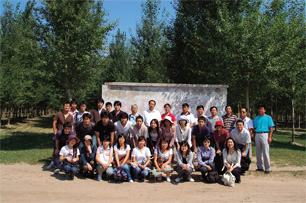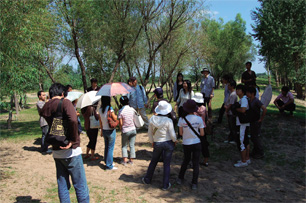Environmental Efforts of Keio University Faculty
Planting trees in a Shenyang desert to create a 100km long dust shield
Keio University’s Research Center for the Chinese Environment carries out a variety of activities, such as building a bio-briquette plant to control air pollution, remediating alkali soil and planting trees in Shenyang City of Northeastern China, aiming at solving environmental problems of the country. Here, we introduce Keio University’s academic project to fight against China’s environmental problems through talk with Professor Hikaru Sakuramoto of the Faculty of Business and Commerce, who was involved in these activities, and two Keio University students who were involved in the tree-planting project in Shenyang.
Keio students joined to understand the present situation of China’s Environmental problems
Located 200km northwest of Shenyang City in northeastern China, Kangping County is adjacent to the desert area of Nei Mongol, and was badly damaged by sand coming from the desert. Every year, alkali soil would blow into the area in about a 20m width to damage the crops, and the village was poor. In April 1999, in response to a request from China, Keio University’s Research Center for the Chinese Environment started a poplar tree planting project in the desert area to remediate alkali soil and to create a shield against wind and dust. The grand project was to plant trees in an area as large as 100meter wide and 100kilometer long.
Keio University offered the poplar seedlings, and through an event called “Tree-Planting Festival”, local residents from elementary school children to adults started to plant the trees. In the first experimental tree-planting of 1999, the size was 0.7square kilometers. The Research Center for the Chinese Environment continued the project, and in 2002, Keio students participated in the project in Shenyang for the first time. Professor Sakuramoto was reluctant at first to have Keio students participate. “There are risks in taking Keio students to a foreign country. However, the environment is the most important issue for us humans in the 21st century, and it is important for young people to feel this in their bones, and it was worth the hardship to take students to the site of the tree-planting project.”
Those who participated were students from seminar classes of Professor Yoko Wake and Professor Hitoshi Hayami of the Faculty of Business and Commerce, and Professor Kanji Yoshioka of the Keio Economic Observatory. All of them majored in fields related to environmental issues.
The tree-planting that started in 1999 in Kangping County of Shenyang City completed half of the original plan in summer of 2007. The poplar trees that were planted in the early stages have now formed a forest to hydrate the wild desert.
Realizing a recycle-oriented environmental improvement that connects farming villages and cities
Keio University’s environmental activity in China started much earlier than the tree-planting in Shenyang, and it actually dates back to the mid 80s. Professor Sakuramoto explained how it all started.
“Back then, Professor Yoshikazu Hashimoto (presently Professor Emeritus) of the Faculty of Science and Technology and Professor Tatsuo Yamada (presently Professor Emeritus) of the Faculty of Law had started a joint research program on the environmental problem of China. Based on this, Professor Ryosei Kokubun, Dean of the Faculty of Law, Professor Tomoyuki Kojima who passed away in 2008 (Faculty of Policy Management) and myself joined in to establish the Research Center for the Chinese Environment, and have managed the team, taking advantage of Keio University’s multidiscipline knowledge as a comprehensive institution.
At the beginning, the biggest problem of China’s environment was sulfur dioxide from burning coal, which was the energy source of the Chinese economy. We wanted to do something about the increasing rate of lung cancer and air pollution, so we established a bio-briquette plant.”
A mixture of plant resources such as rice straw and kaoliang, lime and coal powder of pea coal and coal briquettes are baked at a high temperature and molded into bio-briquettes. Desulfurized lime is produced in the process, and this helps improve soil quality.
“Bio-briquettes help improve air pollution in the cities, and also improve soil quality in farming villages. In this project, we were able to realize a recycle-oriented environmental improvement.”
The Research Center for the Chinese Environment tried mixing the desulfurized lime in the alkali soil of Kangping County. After years of learning by mistake, in the test field in the middle of the barren wasteland, corn, which never grew in this land, grew higher than our height with lush leaves. This activity led to the tree-planting project.
Approval of CDM also in the picture
Today, the tree-planting project in Shenyang aims to be approved by CDM (clean development mechanism) of the Kyoto Protocol. CDM approval of a university-launched project is rare worldwide, and it is highly expected that this will be an important example for the future.
In the basis of this project underlies the spirit of practical learning passed on from Yukichi Fukuzawa. Based on the history in which we have overcome pollution problems, providing energy saving and other environment-related technologies to the world is what we Japanese can do to contribute to the environment. To nurture leaders for such contributions is also an important mission of Keio University.


